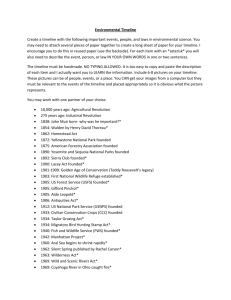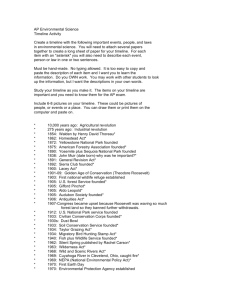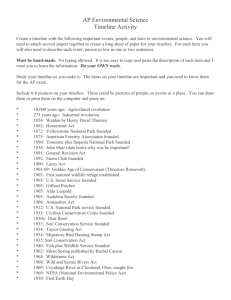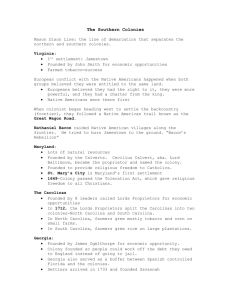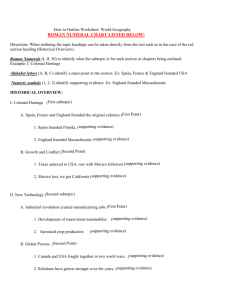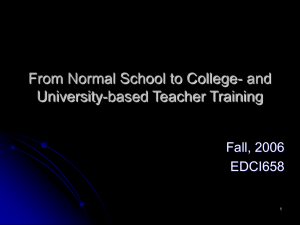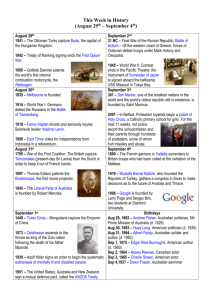File - Michael A. Smith EDLD 8735 Electronic Portfolio
advertisement
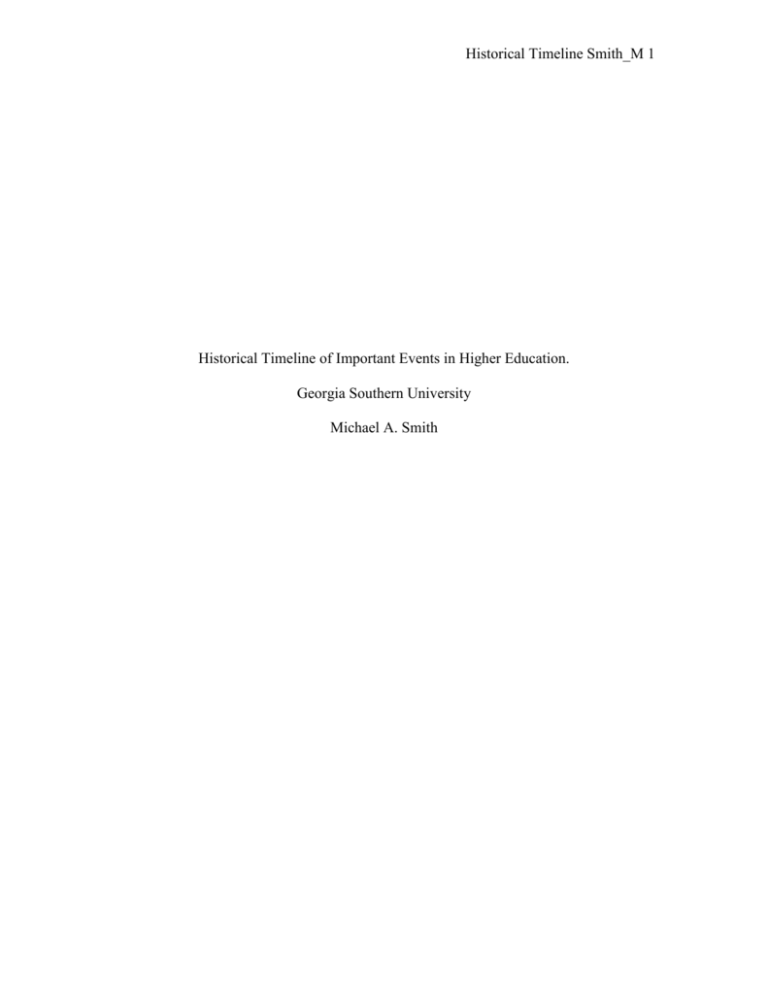
Historical Timeline Smith_M 1 Historical Timeline of Important Events in Higher Education. Georgia Southern University Michael A. Smith Historical Timeline Smith_M 2 30th Century BC Cuneiform is invented by ancient Mesopotamians. This is the earliest form of writing and literacy and is the earliest form of education in its time. 5th Century BC Sophists in Athens and Greece. The era of teaching of wisdom. The first use of full time teaches that were paid for that they were teaching. In addition, the teaching brought about form of inquiry and debate between individuals with opposing viewpoints based on asking and answering questions to stimulate critical thinking and to illuminate ideas. 428 BC Philosophic schools are created and this is the early stages of the college and university. Schools are created that are dedicated to the teaching of large groups of students. 1140 University of Paris, France and the University of Bologna, Italy are founded. These are two of the first 5 original universities to be founded in the 12th and 13 Century. 1167 Oxford University is founded in England. It becomes the 3rd university to be founded and part of the originally 5 universities that were first created. 1217 Salamanca University is founded in Spain. It becomes the 4th university to be founded and part of the originally 5 universities that were first created. 1259 University College is founded in England. It becomes the 5th university to be founded and part of the originally 5 universities that were first created. It was the final university created during this time. 1636 Harvard is the oldest institution of higher learning in the United States. It was founded 16 years following the arrival of the Pilgrims and is part of the “Colonial Nine”. The university has grown from having 9 students and a single master, to an enrollment of over 18,000 degree candidates. 1645 The Roxbury Latin School was modeled on the English grammar school. The school was to give instruction in the classics and to produce Christian Citizens. Founded by Reverend John Eliot, to fit students for public service both in church and commonwealth 1693 William and Mary was founded in 1693 by a Royal Charter issued by King William III & Queen Mary. The second-oldest college in Historical Timeline Smith_M 3 America. A perpetual College of Divinity, Philosophy, and Language. 1701 Yale University founded; when the charter was granted for a school (Collegiate School of Connecticut) wherein Youth may be instructed in the Arts and Sciences through the blessing of Almighty God may be fitted for Publick employment both in Church and Civil State. The school was renamed Yale College in 1718 after the Welsh merchant Elihu Yale. 1746 College of New Jersey was founded later would be renamed to Princeton University. The College of New Jersey was founded for the Education of Youth in the Learned Languages and in the Liberal Arts and Sciences. The charter specified that any person of any religious denomination whatsoever might attend. The College moved to Princeton in New Jersey in 1756, and was renamed Princeton University in 1896. 1754 King’s College was founded in 1754 by royal charter of King George II of England. First American medical school to grant the M.D in 1767. The College reopened in 1784 after the Revolutionary War and was given a new name, Columbia College. 1755 The University of Philadelphia is founded; The College of Philadelphia was the only college that was not at first under church control but the Anglicans quickly began to dominate this preRevolutionary college. The College of Philadelphia was renamed the University of Pennsylvania in 1791. 1764 College of Rhode Island (Brown University) The seventh-oldest college in the U.S. was founded as a Baptist institution and registered its first students in 1765. It moved in 1770 to its present location on College Hill, overlooking the city of Providence, RI. The first women were admitted in 1891, establishing the Women’s College, later known as Pembroke College. It was renamed Brown University in 1804 in recognition of a gift from Nicholas Brown. 1766 Following the Revolutionary War, Queen’s college (Renamed Rutgers University) struggled financially and school trustees considered options such as moving the college to New York or merging the college with Princeton. The merging measure failed by one vote. In 1825, renamed Rutgers College to honor trustee and Revolutionary War veteran Colonel Henry Rutger 1769 Dartmouth College is founded. The last institution of higher learning established under Colonial rule (9th oldest college in Historical Timeline Smith_M 4 U.S.) Dartmouth established a college for the education and instruction of Youth of the Indian Tribes in this Land and also of English Youth and any others. 1787 Northwest Ordinance is passed which states that sections of land in every new township with be set aside for the support and continued growth of education. 1819 Dartmouth v. Woodward case; a legal battle involving the state of New Hampshire and Dartmouth College. The state of New Hampshire attempted to gain control over Dartmouth (a private institution) because of its charter and its financial support of the institution. Supreme Court ruled in favor a Dartmouth and closed doors on any future attempts by states to gain control of private institutions. This in turn gave us our present day separation of private and public higher education institutions. 1835 University of Virginia is founded. This is viewed as the first real state university in the 19th Century. It was listed as a public university because of the following; The university had a board of visitors appointed by the governor of the state; The state provided initial capital and ongoing funding for the operation of the university The university was founded to be free of domination of any and all religious sects; and Provisions were made for the provision of free tuition to selected poor students from throughout the state. 1828 The Faculty Yale Report is published; written by Yale faculty to defend the thorough study of the ancient languages. A special committee was appointed to inquire about the elimination of "dead languages" from college curriculum. 1833 Oberlin College is founded in 1833. In 1835 Oberlin became one of the first colleges to admit African American students. In 1837, Oberlin College admitted four female students, making it the oldest coeducational institution in the United States. 1862 First Morrrill Act Passed; Signed into law by President Abraham Lincoln in 1862. Eligible states received 30,000 acres of federal land to establish colleges/universities. Colleges and universities assisted by this federal funding focused on educating farmers, scientists, and teachers. 1890 Second Morrill Act Passed; The Second Morrill Act proposed to extend access to higher education by providing additional endowments for all land-grant universities. However, this act also Historical Timeline Smith_M 5 prohibited distribution of money to states whose colleges made distinctions of race in admissions. 1944 The Servicemen’s Readjustment Act (otherwise known as the GI Bill) is passed, opening the doors of higher education to veterans of World War II. This is the first of a series of “GI Bills” that provide federal financial support for education to veterans. 1947 The Truman Commission Report lays the policy groundwork for dramatically increased participation in higher education throughout the U.S. In addition to its call for more universal access to higher education, the most important enduring legacy of the report was the promotion of the community college system across the United States. 1954 U.S. Supreme Court rules in the Brown v. the Board of Education of Topeka decision that “separate but equal” educational facilities are unconstitutional. 1961 President John F. Kennedy issues an executive order creating the President’s Committee on Equal Employment Opportunity, which refers to ‘affirmative action’ for the first time. 1963 Congress passes The Vocational Education Act, reflecting a national commitment to enhancing vocational training pushing for better programs in the technical and community college environment. 1964 Civil Rights Act passed, which protects people from discrimination based on race, color or national origin. The official begins of desegregation and the equal rights movement of that time. Because of the need to determine institutional eligibility for new federal grants and assistance, the Federation of Regional Accrediting Commissions of Higher Education is formed to establish common procedures and policies for accrediting colleges 1965 Higher Education Act Passed; The Higher Education Act of 1965 was the first federal measure that provided financial support to both public and private colleges in addition to individual students. Since 1965, the HEA has been amended seven times (1972, 1976, 1980, 1986, 1992, 1998, and 2008). 1967 The Carnegie Commission on Higher Education is established with Clark Kerr at the helm. This commission would create a grading standard for all colleges and universities. Historical Timeline Smith_M 6 1969 Yale and Princeton accept their first women undergraduates. This moves Ivy League education closer to full coeducation status and desegregation of higher education has begun. 1970 Carnegie Classification of Institutions of Higher Education is developed by the Carnegie Commission on Higher Education. It is formally published in 1973 with revisions published in 1976, 1987, 1994, and 2000 1972 Reauthorization of the Higher Education Act, in which Title IX prohibits discrimination based on gender, marital, and parental status in the following areas: admissions, financial aid, health and insurance benefits, career guidance and counseling services, housing facilities, courses and other educational activities, and scholastic, intramural, club, or intercollegiate athletics. The Act also includes the Basic Equal Opportunity Grant; renamed the Pell Grant in 1980 – affirming the nation's commitment to providing equal educational opportunity for the disadvantaged. 1973 The Rehabilitation Act of 1973 (Section 504) establishes protections for persons with disabilities who wish to apply or are enrolled at an institution of higher education. 1974 The Council on Postsecondary Accreditation is established by the merger of the National Commission on Accreditation and the Federation of Regional Accrediting Commissions of Higher Education to serve as the recognizing body for accrediting agencies 1975 The Education for All Handicapped Children Act, later modified in 1990 to become the Individuals with Disabilities Education Act, ensures a free appropriate public education to students with disabilities in the least restrictive environment and open doors for more qualified students with disabilities to enter postsecondary education. 1979 11.6 million students are enrolled in colleges and universities in the United States. In a permanent shift, more than half are now women. The U.S. Department of Education is created. This agency would monitor and the progress of student and the funding of schools. Historical Timeline Smith_M 7 1983 Proposition 48 is passed by the National Collegiate Athletic Association, toughening the academic requirements for freshmen athletes in Division I sports 1984 Congress passes The Carl D. Perkins Vocational Education Act, amending the Vocational Education Act of 1963 to provide federal assistance to states, including the use of funds for vocational education opportunities, authorized special programs, sanctioned national programs, and established evaluation criteria. 1990 Americans with Disabilities Act (ADA) provides further protections for persons with disabilities who wish to apply or are enrolled at an institution of higher education. 1992 U.S. Supreme Court’s U. S. v. Fordice ruling makes headway toward desegregation of statewide systems of higher education 1993 The Commission on Recognition of Postsecondary Accreditation is established as a stopgap measure to recognize voluntary accreditation associations after the Council on Postsecondary Accreditation was dissolved. 1997 The Council for Higher Education Accreditation is established as the recognizing body for accrediting organizations, taking over responsibility from the Commission on Recognition of Postsecondary Accreditation. 1998 The Department of Education establishes the Distance Education Demonstration Program to determine how to change the regulatory and legal barriers which discourage distance education programs. The National Commission on the Cost of Higher Education releases a report which notes the rise in tuition over the last twenty years, and calls on colleges and universities to take steps to reduce their costs and become more affordable. 2007 College Cost Reduction and Access Act; his act provided the largest increase in federal student aid since the GI Bill. This was accomplished through subsidy cuts in the student loan program. 2008 Ensuring Continued Access to Student Loans Act; this act attempted to stabilize student loan funding so that lenders would continue to participate in Federal Family Education Loan Programs (FFELP). Historical Timeline Smith_M 8 2009 Race to the Top Program; the program provides competitive grants to encourage and reward States that are creating the conditions for education innovation and reform.” Some key components of the plan include making substantial gains in student achievement, closing achievement gaps, improving high school graduation rates, and ensuing that students are prepared for success in college and careers.
